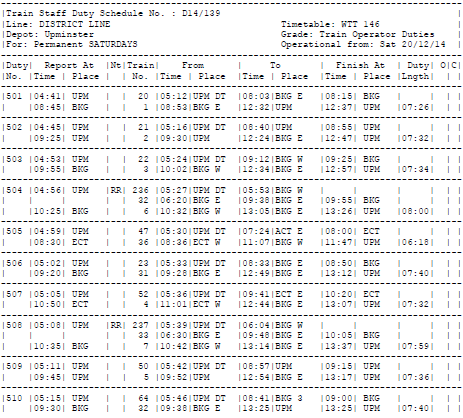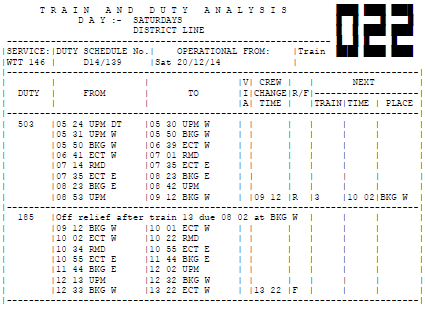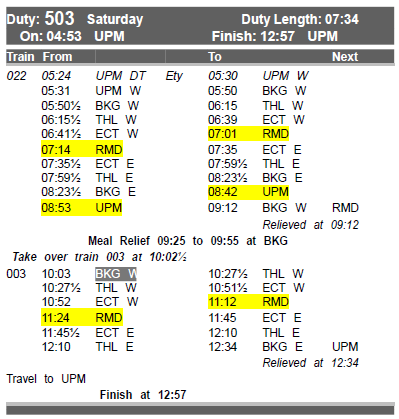neilw
now that's what I call a garden railway
Posts: 284
|
Post by neilw on Nov 23, 2015 14:34:09 GMT
I know that the WTT details the running of trains under their train or set numbers. What is the correct term for the document which tells train crew what their duty is, which train to pick and where, etc? I remember on the Central in the seventies they were linen back documents which folded up. Any examples anyone can post of either then or current practice? Many thanks
Thread title capitalised. Thanks DomK
|
|
North End
Beneath Newington Causeway
Posts: 1,769
|
Post by North End on Nov 23, 2015 15:00:45 GMT
I know that the WTT details the running of trains under their train or set numbers. What is the correct term for the document which tells train crew what their duty is, which train to pick and where, etc? I remember on the Central in the seventies they were linen back documents which folded up. Any examples anyone can post of either then or current practice? Many thanks There's duty schedules which exist for both normal and special working, which break down each duty, and are normally posted in a folder at each booking on point (or alternatively they could be placed in a notice case) - however these only quote the locations where the crew will take over and hand over the train, they don't say where the train goes. To provide more detailed information about each train, there's the "train & duty analysis", which contains a set of sheets detailing the working of each individual train. Again there will be separate versions for Mondays to Fridays, Saturdays and Sundays, plus separate ones for special working. These will again normally be provided in a folder at each booking on point. When special working applies, crews will normally need to consult the duty schedule and note down each train their duty works, then consult the analysis sheets to see where the train goes. Finally, crews should check the Working Timetable or Timetable Notice for any additional notes, or most importantly to identify if they are the last train. For normal day-to-day purposes, most lines produce a Duty Book which collates all the relevant information. However, the caveat is the duty book is not always an official publication. I believe some lines also produce a "Set Working Book". I've never worked with one, however my understanding is it's an official version of the duty book. Only a couple of lines had this, not sure if they still do. |
|
|
|
Post by Dstock7080 on Nov 23, 2015 15:31:21 GMT
I believe some lines also produce a "Set Working Book". I've never worked with one, however my understanding is it's an official version of the duty book. Only a couple of lines had this, not sure if they still do. The last 'Set Working Book to Working Timetables', for District and H&C Lines, was produced in December 2012. These didn't have Duty details, just what each 'set' (= train on non-proper Lines!) did each day i.e: "Set 16 6-cars | Dt Up | 0610 |
| | Empty | | Up | 0616 | E Bdwy | 0750 | | | E Bdwy | 0801 | Bkg | 0917 | | | Bkg | 0918 | Bkg21 | 0923 | Empty | | Bkg21 | 0933 | Bkg | 0936 | Empty |
| Bkg | 0936 | Wdon | 1052 | AC | | Wdon | 1107 | Mans H | 1147 | DY | | Mans H | 1152 | Rmd | 1230 | |
|
|
Deleted
Deleted Member
Posts: 0
|
Post by Deleted on Nov 23, 2015 15:45:50 GMT
There's an old example here, not sure how current it all is now, though. For normal day-to-day purposes, most lines produce a Duty Book which collates all the relevant information. However, the caveat is the duty book is not always an official publication. On the Northern (City branch) driver's eye view video by Video 125, the following conversation can be heard between Train 53, approaching Kennington N/B, and someone at Cobourg Street (presumably someone on signals or the line controller): |
|
North End
Beneath Newington Causeway
Posts: 1,769
|
Post by North End on Nov 23, 2015 16:04:38 GMT
I believe some lines also produce a "Set Working Book". I've never worked with one, however my understanding is it's an official version of the duty book. Only a couple of lines had this, not sure if they still do. The last 'Set Working Book to Working Timetables', for District and H&C Lines, was produced in December 2012. These didn't have Duty details, just what each 'set' (= train on non-proper Lines!) did each day i.e: "Set 16 6-cars | Dt Up | 0610 |
| | Empty | | Up | 0616 | E Bdwy | 0750 | | | E Bdwy | 0801 | Bkg | 0917 | | | Bkg | 0918 | Bkg21 | 0923 | Empty | | Bkg21 | 0933 | Bkg | 0936 | Empty |
| Bkg | 0936 | Wdon | 1052 | AC | | Wdon | 1107 | Mans H | 1147 | DY | | Mans H | 1152 | Rmd | 1230 | |
Interesting; thanks. What was the reason for these books being produced? |
|
|
|
Post by Dstock7080 on Nov 23, 2015 16:17:59 GMT
Interesting; thanks. What was the reason for these books being produced? I remember on the Central in the seventies they were linen back documents which folded up. Traditionally, the Surface lines didn't use Running Cards as could be found on the Tube. |
|
|
|
Post by rheostar on Nov 24, 2015 8:14:17 GMT
Traditionally, the Surface lines didn't use Running Cards as could be found on the Tube. I didn't know that. The Surface lines seemed to be a different railway to the tube lines back then. They still are to a certain extent. I remember the linen based running cards from the 70's. We'd scrabble about in a box trying to find the right card for our duty. These days, enterprising drivers in some depots produce books with the duty running details in them. |
|
|
|
Post by Dstock7080 on Nov 24, 2015 9:12:57 GMT
These days, enterprising drivers in some depots produce books with the duty running details in them. Duty Books are now produced officially for all Train Staff depots, hence the withdrawal of the Set Working Books on the District and H&C. |
|
Colin
Advisor
My preserved fire engine!
Posts: 11,347
|
Post by Colin on Nov 24, 2015 16:30:13 GMT
I know that the WTT details the running of trains under their train or set numbers. What is the correct term for the document which tells train crew what their duty is, which train to pick and where, etc? I remember on the Central in the seventies they were linen back documents which folded up. Any examples anyone can post of either then or current practice? Many thanks As the original question dosen't really seem to have been answered..... Firstly each depot has a rota, or in some cases several rota's. If we take the District line as an example, the West end depots at Acton Town and Earls Court have what is known as a "link system". Each depot has an Early turn rota and a late turn rota (so drivers only work just earlies or just lates all the time) - Earls Court, being a bigger depot, also has a "late early" rota, a "middle turn" rota, an "early lates" rota and a nights rota. In addition to those "fixed links" both depots have a mixed rota (bit of everything except nights) so drivers are able to have a choice of which rota they want to work. That being said, the choice is dependant on what's available!..... When a driver starts at any depot they go into that depot's "pool". This is a group of drivers outside the rota(s) and are used to cover for annual leave, training, sickness, etc. From the "pool", you get put onto a rota when a space becomes available. If you request the late turn rota you'll probably go straight on as its not very popular, but if you nominate the early turn rota you'll end up on a waiting list and work the mixed rota initially (early turns are always far more popular!). Some people will just go on the mixed rota and swap duties as and when they need to. At the East end of the District line, at Barking and Upminster, we just have one rota for the whole depot (plus the pool) and operate what's known as the mafia system. A certain number of drivers join the "mafia" and their duties all "go into the pot" and are redistrubuted according to preference - usually earlies or lates, but some may have a particular requirement like always having a Tuesday rest day or only work Monday to Friday, etc. At Upminster in particular - its my depot - the rota is "balanced". It's currently 132 weeks and is thus divisable by 4. Because it's divisable by 4 we are able to work two weeks of earlies followed by two weeks of lates followed by two weeks of earlies, etc, etc......that means the "mafia" members must be in the right place on the rota to ensure things remain balanced, so there is a waiting list to join it otherwise there'd be chaos!! Why the different systems at each end of the line? Cos the depots voted to work the system they have! I've worked under both and there's advantanges and disadvantges to both. To be honest, I'm quite happy following Upminster's rota. So, how do I know what I'm doing? Here's a part of our old rota at Upminster (note this is not the current rota and so the forum rules are not being broken):  Shall we say its Saturday and this week I'm on rota line 9........so I'm working 503 duty. The rota is course posted within the book on point at every depot, as are the actual duties - and these look like this (again this old out of date information):  So the rota showed the book & book off times but now we know which trains we're working, what times we're on them and where we pick them up and get off them. 503 duty brings train 22 out of the depot and has the meal break at Barking before doing a bit more work on train 3. Coupled with a copy of the working timetable now have enough information to work out the full duty and that's all we need when there's engineering works......however there is a cheat to save bothering to look it up in the timetable..... Duty managers at the depots use something called analysis sheets. These show what each train dose, and in particular how each train is crewed. Drivers either copy the details off these sheets or if the manager is feeling generous, drivers may get a photocopy. Usually we just copy the details at the east end but the west end get actual photocopies! Anyway, the relevant anaylisis sheets for duty 503 are trains 22 and 3 (note only part of A4 page shown here):   Of course doing this every day with our permanent duties would be a bit laborious and get through a fair bit of paper, so we do have duty books for the permanent duties. As mentioned up thread these are now produced by the company. For completeness, the duty book page for 503 duty looks like this (again this is old information - the current saturday 503 duty isn't the same!):  |
|
neilw
now that's what I call a garden railway
Posts: 284
|
Post by neilw on Nov 24, 2015 16:36:32 GMT
Brilliant, thanks Colin for a very comprehensive answer
|
|
|
|
Post by rheostar on Nov 24, 2015 16:47:24 GMT
These days, enterprising drivers in some depots produce books with the duty running details in them. Duty Books are now produced officially for all Train Staff depots, hence the withdrawal of the Set Working Books on the District and H&C. Yep, I forgot that the duty books are produced by LU now. Back in the day.... |
|
|
|
Post by yerkes on Jan 6, 2016 12:58:40 GMT
Also back in the day, my father spent much of his working life at 55 Broadway creating duty sheets. All hand-written in those days, and he enjoyed the mathematical challenge of getting a line's duty sheets to work out in the most efficient way possible.
|
|
|
|
Post by revupminster on Jan 6, 2016 18:57:49 GMT
As a depot clerk for a time I remember the set working and duty timetables. Each duty had a value depending on how much it went into unsocial hours. The earlier it started or later it finished the more value it had. A weekly value for a set of duties would be paid.
Now train crews continually swapped shifts, some only did earlies and some lates, swapped rest days or overtime due to late running. Changing a start time by a few minutes altered the value of the shift and the crews wanted the difference.
So over a week the timebook (handwritten) became a work of art as crews changed duties with every black entry having a corresponding red entry. Late changeovers at the end of the week were carried forward to the next week.
|
|



